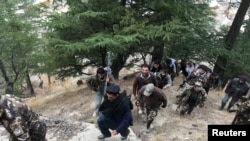Lawmakers in the eastern Afghan province of Nuristan say Islamic State (IS) militants are carving a new sanctuary in the province by recruiting from parts of the remote mountainous region.
Maulvi Ahmadullah Mohid represents Nuristan in the Ulasi Jirga, or lower house of the Afghan Parliament. He told Radio Free Afghanistan that the ultra-radical militant group is currently active in five out of eight Nuristan districts.
Alpine forested valleys in the five districts -- Mandol, Duab, Nurgram, Waygal, and Wama -- provide an ideal territory for guerrilla warfare.
“Their activities are gathering momentum every day. IS militants are now virtually ruling the regions outside government control alongside the Taliban,” he said. “IS is getting stronger in the districts of Duab and Mandol, from where they want to project power into some neighboring provinces.”
Sadullah, head of Nuristan’s provincial council, said an illegal IS FM station is now broadcasting in Nurgram district. “Their main focus is recruiting people,” he said.
The development has significant repercussions. In recent months, Afghan and U.S. officials have repeatedly claimed that an IS sanctuary in eastern Jalalabad Province, some 100 kilometers south of Nuristan, is rapidly shrinking as a result of relentless military operations that have killed a large number of IS fighters and leaders.
A new sanctuary in a remote Afghan province will not only help IS regroup but will pave the way for its expansion into new regions.
Javed Kohistani, a Kabul-based security analyst, said an IS stronghold in Nuristan will help its ultra-radical Islamist militants to infiltrate into neighboring provinces in central and northeastern Afghanistan and pose a major security threat.
“It will become a rare base for Daesh. It will emerge as the No. 1 security threat for several neighboring provinces,” Kohistani said, referring to IS by its local name. “But internal differences and a muddled [counterterrorism] strategy prevent the government from acting to stop or neuter Daesh activities in the region.”
Nuristan abuts Pakistan’s Chitral region in the east and borders Afghanistan’s Badakhshan, Panjshir, Kunar, and Laghman provinces. The region also has a long history of Salafi activism and has been home to various militant groups.
The region was largely free during the Soviet occupation of Afghanistan in the 1980s, and a local cleric, Maulavi Afzal, even established an Islamist mini-state. After 2001, it became one of the most dangerous places for international forces. Wanat, a U.S. military outpost in Nuristan’s Waygal district, was the scene of a major battle in 2008.
Late last year, Afghan authorities called on Nuristan elders to help them prevent IS militants from gaining a foothold in the province.
In December, a local official told Reuters about the IS presence in Nuristan. "They are trying to win local support and recruit young boys, the same method they used when they emerged in Nangarhar," he said, speaking on the condition of anonymity.
A local IS affiliate that branded itself as Khorasan Province emerged in Nangarhar in early 2015. Drawing most of its leaders and fighters from the Pakistani Taliban, it overran several mountainous districts in the region that year.
Afghan and U.S. officials now, however, claim to have reduced IS forces to a few hundred fighters from its peak strength of 3,000. They claim to have rid most districts of an IS presence.
Last month, U.S. and Afghan forces claimed to have killed more than 750 IS fighters. The group’s leader, Abdul Haseeb, was also reportedly killed in one of the battles in Nangarhar in May.
Abubakar Siddique wrote this based on Radio Free Afghanistan correspondent Nazifa Mahbubi’s reporting from Kabul, Afghanistan.







